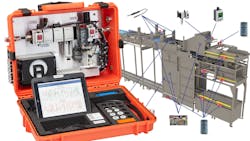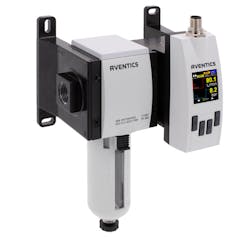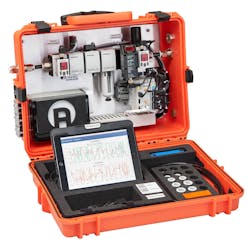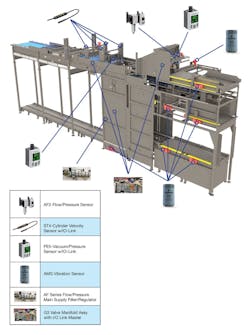Why Using IIoT for Pneumatics is Simple, Yet Critical
At a Glance:
- Know the right questions to ask when it comes to managing data.
- In the scope of pneumatics, installing IIoT applications and improvements of just a few percentage points mean major savings in energy dollars.
- Incorporating IIoT solutions within packaging machinery could become a standard expectation of OEMs.
The Industrial Internet of Things (IIoT) is disrupting manufacturing. The applications for collecting sensor data and using it to optimize machine performance are limitless. Solution providers are developing ever-enhancing tools to automate data ingestion, interpret the “ones and zeros” and enable stakeholders to access solution insights remotely. Remote access to plant performance and machine reliability data will be increasingly important for the “work-from-home” era that the global COVID-19 pandemic has created.
Not only are IIoT solutions getting better over time, but they are also getting less expensive, which is great news for manufacturing organizations searching efficiency upgrades. All of this brings holistic, operational benefits to the company and it all sounds great…but where do you even begin?
Like any new venture, there will inevitably be bumps in the road and growing pains when implementing IIoT technology. Still, with a little research and a helping hand from subject matter experts, you can leverage new technology to the benefit of your company.Below are some questions that will need to be answered, regardless of whether project leaders are working with in-house IIoT specialists or engaging third-party professionals. Knowing the right questions to ask when it comes to managing data can be a big time and cost saver up front as well as in the long term. Consider the following:
- Will sensor data be transmitted wirelessly?
- Will data be visualized on a local HMI or with a mobile app?
- Will it feed into a locally hosted or cloud-based database?
- Will it be saved and formatted for future analysis in combination with supplementary data?s
- Will there be a requirement for new data to be compatible with existing software platforms?
- Is there an existing data analytics strategy or will one need to be created?
- Will data from multiple machines be aggregated?
- Will data from multiple plants need to be viewed remotely by management or a corporate official?
IIoT and Pneumatics
In the scope of pneumatics, IIoT applications are generally initiated by a desire to improve energy efficiency. Depending on the size and nature of the equipment in question, improvements of just a few percentage points can mean tens of thousands of energy dollars saved each month.
We all know that air leaks are a continual issue with pneumatically powered equipment, but how can you determine how that lost air translates into wasted dollars? The obvious answer is that you have to measure air usage and use your local energy rates to calculate costs. What isn’t obvious is choosing which sensor and software tools you should use to quantify pneumatic inefficiency. Answers to the technical questions above will help to guide decisions about which solutions to deploy.
Let’s say you have a pneumatic packaging application and you’d like to leverage an IIoT solution to optimize energy efficiency. After consulting with solution providers, you may find that there are opportunities to enhance your results by also tracking performance of key components and overall machine health to maximize the useful life. This implies the need for continuous monitoring of air usage and performance/health parameters as opposed to a one-time, audit-style measurement/assessment.
Let’s assume that your facility has an existing data collection and analysis software platform, and your operations team agrees that air and performance data should be integrated into it. We now have some critical design criteria to work with, and your IIoT-enabled efficiency solution is well on its way to being realized.
Scope creep is a constant reality with any technology initiative; it’s already happened here in our hypothetical pneumatic monitoring application! We started with energy efficiency and now we’ve added performance and overall health monitoring to the equation. To implement a comprehensive pneumatic IIoT strategy like this, we will need more than just air usage data.
The palletizer application illustration shows a high-speed, bulk palletizer equipped with a comprehensive machine health monitoring solution from a leading solution provider. Capturing the necessary data for this application requires cylinder velocity sensors and mechanical cushioning wear sensors for lifecycle management, pressure sensors, vibration sensors and leak detection devices (such as air supply and consumption sensors). In this scenario, data from the network of sensors is analyzed by software running on an edge computer and insights are stored in an existing platform or data historian for machine learning purposes.
Getting the Project Approved
In addition to assessing data and software architecture on the technical side, an experienced IIoT pro will also help to ensure the project accomplishes your financial goals. You will need to know if your company has established criteria for calculating ROI and whether there is a minimum payback timeline requirement for plant upgrades. This information will be used in project budgeting and the approval process.
Thankfully, IIoT solution providers generally design their technology to be modular and scalable. In addition, many offer “starter kits” that are specifically designed to prove the benefits of a full-scale solution without requiring users to make a big investment up front. These offerings are extremely helpful when you need to show concrete proof of project savings potential to decision makers in your organization before large capital or operational expenses are approved.
Ensuring the Best Possible Outcome
The IIoT solution market can be intimidating, but don’t let fear keep you from experiencing the benefits promised by new technologies. Incorporating IIoT solutions within packaging machinery will effectively redefine the term “state-of-the-art machine” and could become a standard expectation of OEMs in the near future. The ability to track OEE (overall equipment effectiveness), predictive machine health KPIs, environment conditions and energy consumption will enable packaging operations to reach new levels of efficiency and reliability.
Modern IIoT solutions also create the potential to monitor multiple machines simultaneously, which could reduce variation between similar packaging machines. In addition, the connectivity aspect of these technologies allow technicians and managers to supervise machine performance and troubleshoot problems remotely. The packaging industry will substantially benefit from predictive health and machine monitoring technology solutions. A great place to start your IIoT journey is with the help of professionals who will help steer you in the right direction by asking the right questions. Engaging your IIoT specialist or a qualified third party will be key to avoiding costly obstacles and reaching your continuous improvement goals.
Justin Lesley, Industry 4.0 innovation manager at Motion Industries, directs IIoT strategy and partnerships related to the MRO industry. He guides manufacturers along their digital transformation journey by helping them utilize connected predictive maintenance solutions.
Chris Noble is business development F&B/IIoT consultant, Emerson Automation Solutions business development manager, working with industrial automation, F&B and packaging industries OEMs for Emerson. He specializes in digital Transformation/IIoT, consulting with CPGs and OEMs on how to engage and implement machine health monitoring and analytics on capital equipment.
For more information, visit MotionIndustries.com/hydraulicsandpneumatics or learn about Mi On-Site Solutions.
About the Author
Justin Lesley
ndustry 4.0 Innovation Manager, Motion Industries
Justin Lesley, Industry 4.0 Innovation Manager at Motion Industries, directs IIoT strategy and partnerships related to the MRO industry. Justin guides manufacturers along their digital transformation journey by helping them utilize connected predictive maintenance solutions.



